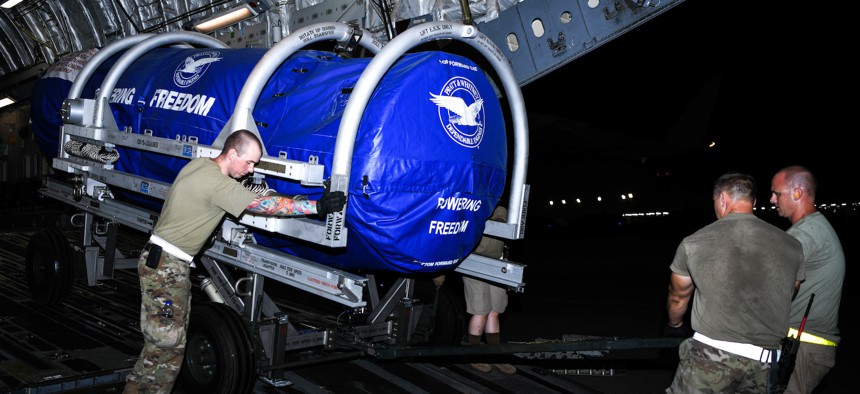
In this 2020 photo, members of the 380th Expeditionary Logistics Readiness Squadron Air Terminal Operations Center wheel an F-35A Lightning II engine out of a C-17 Globemaster III aircraft at Al Dhafra Air Base, United Arab Emirates. U.S. Air Force / Tech. Sgt. Charles Taylor
Air Force: One engine design will fit into both bidders’ next-gen fighters
Two companies are vying to build the service’s secretive NGAD jets.
DAYTON, Ohio—The Air Force is working on one engine design to power the service’s highly secret new fighter jet—no matter which company builds the plane.
The future engine, called Next Generation Adaptive Propulsion, or NGAP, will be able to work in all Next Generation Air Dominance planes being developed, said John Sneden, director of propulsion for the Air Force.
“The design of the NGAP engine will fit into any of the designs for the airframe piece. Now later on, as we downselect and figure out who the final vendor is, then there can be some optimization of that system, that particular design,” Sneden said Tuesday at the Life Cycle Industry Days conference here.
Boeing and Lockheed Martin are believed to be designing a fighter for the NGAD program, while Northrop Grumman announced last week it will not bid on the program. The Air Force aims to pick a winner in 2024.
Sneden said the service is funding two vendors—Pratt & Whitney, which makes the F-35’s current F-135 engine, and General Electric—through the next-gen engine prototyping stage.
Pratt and GE both have teams working on an adaptive engine through a program called the Adaptive Engine Transition Program, or AETP, which was intended to develop engine concepts for the next F-35 engine. However, the service announced in its 2024 budget rollout that it would upgrade the F-35’s existing Pratt & Whitney engine through a program called engine core upgrade, or ECU, and not pursue a new engine through AETP.
Congress has pushed back on the Air Force’s decision to nix AETP and will likely fund the program at some level in the annual defense policy bill to keep technology development moving.
But whether or not AETP gets funded, Sneden said his office will roll the technology that’s been developed over to the next-generation engine program.
“If we get money, I think the focus will actually be on where we [can] spend the money on advanced engine development activities that will help us continue to mature adaptive engine tech, towards the NGAP baseline, as opposed to putting adaptive engine tech in the F-35,” Sneden said.
Air Force Secretary Frank Kendall has said he supports the service’s decision not to fund AETP for the F-35 program, saying it would be a waste.
“The service has made the decision that we're not putting AETP in the F-35. The secretary doesn't want to spend more resources to go do so, but what I think everybody is open to is continuing to mature the technology towards the NGAP program,” Sneden said.
The next-gen engine is currently in the preliminary design phase, but “within the next couple of years, we'll be moving into prototype and test,” he said.
The engines built under the AETP program were sized for the F-35 plane, and while NGAD engines won’t be the same size, the technology baseline is essentially the same, Sneden said.
“Now it's not a one for one, can't just pull it off of the F-35 and move it directly over to NGAP in its current state. So it has to be rescaled, resized, redesigned, but understanding how that technology works is the most paramount thing,” Sneden said.
Sneden also warned about keeping the engine market competitive.
“Our industrial base does not move at a threat relevant cadence. In fairness to my industry partners, they haven't really been challenged or incentivized to do so through the majority of their contracts,” Sneden said.
“The sole source nature of our enterprise also exacerbates that same problem and removes some of those competitive forces that drive innovation, speed, and cost control and as a result, what you get on is on the developmental side, it takes us about 10 to 15 years to get a new propulsion system out to the field,” he said.


